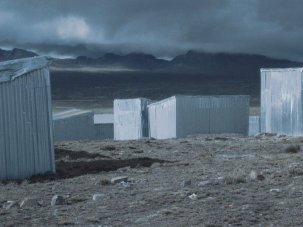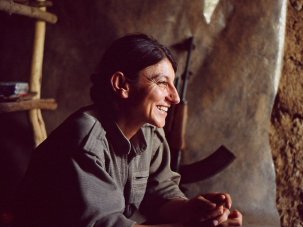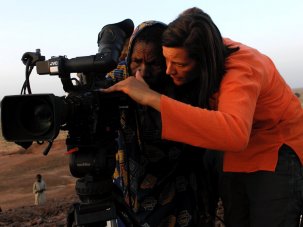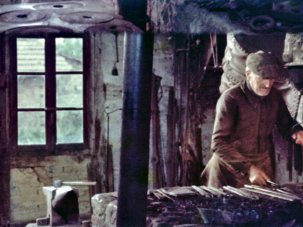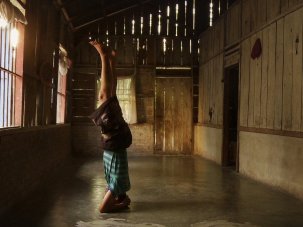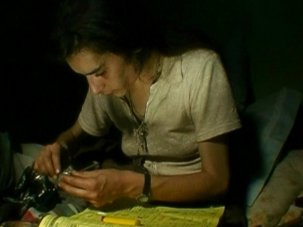“They should pay him for a work actually done,” argues Alfredo García Kalb, the protagonist of Diego Gachassin and Matías Scarvaci’s Docile Bodies, an absorbing observational documentary, which plays at the second Frames of Representation festival hosted at London’s Institute of Contemporary Arts. Kalb is on Argentinian television debating the remuneration for labour of inmates in the country’s penal system, an extension of his work representing petty criminals as a defence lawyer. He’s a larger-than-life personality, charismatic and methodical in his pursuit of fair treatment for those who would otherwise be convicted, locked away and forgotten.
The second Frames of Representation festival runs 21-29 April 2017 at the ICA, London.
Machines is released in the UK on 19 May, The Human Surge in July and La Soledad in August 2017.
This potential fate is the same as that implied in the film’s title. The term itself, ‘docile bodies’, is taken from Michel Foucault’s 1975 book Discipline and Punishment: The Birth of the Prison. It is a reference that proves useful when looking at the entirety of this year’s Frames of Representation programme.
Foucault’s concept of ‘docile bodies’ theorised upon the malleable and receptive human body as the primary object on which disciplinary control is enacted in modern society and culture. He states that such coercive methods have always existed in monasteries and the military, but from the 18th century the practice became more generalised and evident in such diverse institutions as prisons, schools and, most crucially in this context, factories. While Frames of Representation’s inaugural edition last year concentrated on those at the margins of society in the New Periphery, this year the focus is on Working in its many forms. It’s hard to ignore the overlap with Foucault’s ideas in the 11 feature films screening, which are intertwined by thematic threads concerning control, discipline, labour and physicality.

Machines (2016)
Take, for instance, Foucault’s underlying belief that people are like cogs within the mechanics of power: this idea seems to be perfectly encapsulated by Rahul Jain’s Machines, the first film to play at the festival. A sensorial experience of a textile factory in Gujarat, India, the film aurally evokes the rhythmic industrial filmmaking of early Soviet cinema, as the camera floats through what is clearly a suffocating environment.
It is often difficult to distinguish where the technology ends and its operators begin – prompting the question of whether the title refers to the tools or the workers themselves. This feeling is punctuated by interviews – with workers, contractors, and even the factory boss – that provide welcome respite and, more importantly, diverse voices. In one interview, Jain’s interlocutor discusses the subjugation of the workers by undermining any attempts they make to band together and unionise, though this is done both by bosses and other workers. Another man strongly disagrees that he is being exploited – despite having just relayed a nightmarish work schedule – because the factory is giving him the opportunity to work.
Jain is clearly determined to present perspectives other than his own, and FoR is an ambitious festival dedicated to complementary goals. Alongside the screenings are a series of other events and discussions that aim to open dialogues between filmmakers and audiences to question documentary practice and consumption. In the words of festival curator Nico Marzano, “the festival this year aims to expand the parameters of art and activism, offering a space for critical engagement and social commentary.” In the masterclass that preceded the screening of Machines, Jain spoke about the advice of Lucian Castaing-Taylor, the head of the Harvard Sensory Ethnography Lab, who “took a look at one of the earliest cuts and he basically drew two words – sympathy and empathy – and then drew a big ‘v’: sympathy < empathy”.
The sentiment was echoed by Joshua Oppenheimer, the director of The Act of Killing and The Look of Silence, who also held a masterclass on Saturday. “You somehow have to become the other that you want to explore,” he said. One of Oppenheimer’s producers on those two films was Torstein Grude, whose Mogadishu Soldier takes a creative approach to becoming that ‘other’. Rather than stepping into the shoes of his subjects, he gave his camera to them.
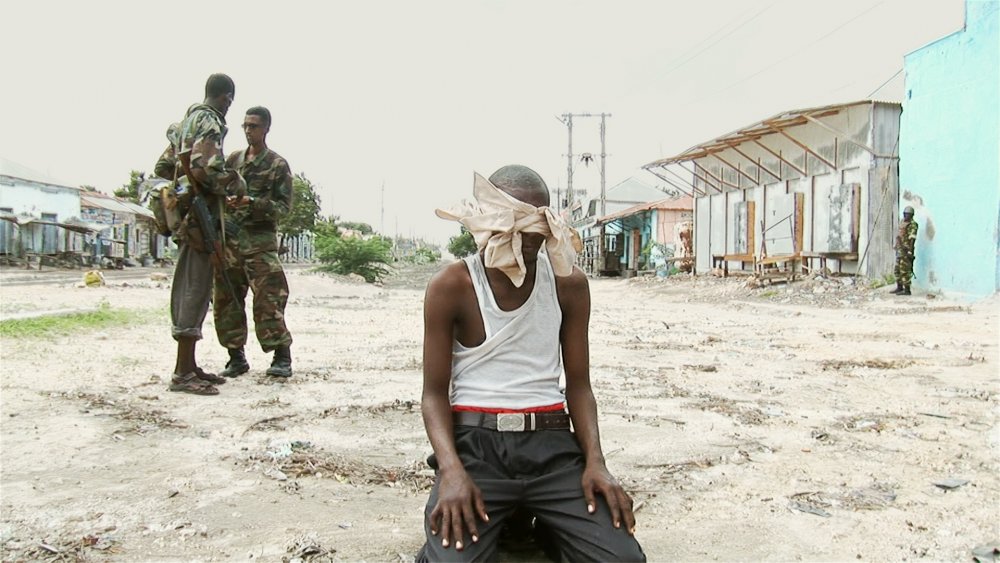
Mogadishu Soldier (2016)
Mogadishu Soldier explores life in the war zone of the Somalian capital through the lens of a group of Burundian soldiers on a peacekeeping mission. Two willing members of the party amassed more than 500 tapes of intimate and often mundane footage from the front line. There are moments of explosive firefights, lost comrades and the bodies of fallen Al-Shabaab adversaries, but they are countered with funny asides and observations of soldiers giving up their own provisions to help feed the locals.
In much the same way that Machines operates, Mogadishu Soldier gives a distinct human face to a conflict rarely afforded one by the Western media. It also makes for a fascinating comparison with Zaynê Akyol’s Gulîstan, Land of Roses – a moving portrait of female militants in the Kurdistan Workers’ Party (PKK), fighting against Daesh (Isis).
In Foucault’s original discussion of ‘docile bodies’ he refers to the military, and military training, as age-old purveyors of institutional discipline. In Mogadishu Soldier and Gulîstan, Land of Roses audiences see two very different examples of combatants. On one side, the Burundian officers are there to work, with provision for their families being mentioned on several occasions: “In our job the problems we face are work-related… a job like any other.” While the motivations offered by the women of the PKK are undeniably complicated and nuanced, they are built on belief in the cause. Although Gulîstan, Land of Roses actually features repeated scenes of instruction it is undercut by playfulness, and while discipline is evident the women’s actions feel rebellious: “Every woman left to the mercy of a man is condemned to slavery.”
Gulîstan, Land of Roses trailer
Whatever induced them to enlist, however, both the Kurdish and Burundian soldiers are explicitly aware of the commitment they have made with their bodies. In Mogadishu Soldier, there is a debate about being prepared to lay down their lives and whether that should be necessary – or even made explicit – during a peacekeeping mission. Gulîstan, Land of Roses meanwhile generally eschews depicting combat itself but includes an affecting scene in which one protagonist presents her testimony to the camera with the knowledge that she may not return from her next operation.
Similarly intimate and emotive are the testimonies given in Pawel Lozinski’s unflinching examination of a strained relationship between a mother and daughter in You Have No Idea How Much I Love You. The film is effectively a handful of short sessions conducted by psychotherapist Bogdan de Barbaro with Hanna and Ewa about their difficulty in communicating.
It’s composed almost entirely of tight close-ups of single individuals against an undefined background, the visual discipline echoing that commanded by Barbaro in the sessions. In a gut-wrenching 70 minutes he carefully excavates both of his patients, uncovering the feelings they’ve struggled to articulate and as a consequence provoking a great deal of empathy in both parties. A closing title card provides further context and only heightens the emotional poignancy.
Another painstakingly constructed depiction of evolving communication can be found in Nele Wohlatz’s Argentinian feature The Future Perfect. In what serendipitously works as a playful riff on Foucault’s notion of the individual being a product of the society, the institutions of work and school inspire the development of a new identity, and freedom, for a Chinese immigrant.
In the opening scene an off-screen interviewer questions Xiaobin about her initial experiences of the Argentinian language. “What did you learn?” she asks. “The names of things and… the names of cold cuts.” Her work at the deli counter in a supermarket provides Xiaobin with the potential to extricate herself from her overbearing family and forge her own life in a new country.
This goes hand in hand with education in a new language, which both makes her a more viable option for Buenos Aires employers and alters her personality and perceptions – the Sapir-Whorf hypothesis in action. Entwined with Xiaobin’s improving Argentinian is Wohlatz’s subtly shifting visual style, which progresses its fluidity and technical proficiency to match its protagonist’s linguistic skill.
The Future Perfect trailer
The Future Perfect also highlights the notion of the contemporary globalised workplace, an idea that also emerges in other films in the programme. A migrating workforce is the focus of Salomé Lamas’s Eldorado XXI and referenced in Omar A. Razzak’s The Calm Tempest and Jorge Thielen Armand’s La Soledad.
Eldorado XXI is concerned with inward migration; it is a portrait of the world’s highest permanent settlement in the Peruvian Andes, and the desperate people forced to settle there to work the mine. “[La] Rinconada is for the people who have tried everything, no?”
After snowy landscapes set the scene, Lamas plunges the camera into a single, hour-long static shot peering into a mineshaft as people trudge up and down its steep incline with head torches lighting their path. The soundtrack cycles through local radio stories and workers relaying their own tales of suffering, exploitation and mysterious deaths. The film’s second half doesn’t lessen the back-breaking severity of life in La Rinconada but it gives a variety of weathered and weary human faces that – as previously – transform the effect from sympathy to empathy. What initially seems as though it might be purely aesthetic formal experimentation takes on tangible emotional and political weight.
Conversely, The Calm Tempest and La Soledad are haunted by the spectre of forced migration away from their homes in search of work. The two films share a number of thematic and even visual motifs. Both portray isolated locations – the Italian island of Ponza and a rundown mansion in Caracas, Venezuela – that use ghostly apparition and the long cold fingers of history to creatively survey the denouement of a specific way of life.
In The Calm Tempest that is an island life of fishermen and lighthouses that is approaching extinction, and Razzak weaves in biblical elements into a discussion of the fear of an uncertain future. Spanish Tenebrist painter Jusepe de Ribera was one of Razzak’s inspirations and the film combines an observational eye reminiscent of Gianfranco Rosi with laments and evocative chiaroscuro portraits that call to mind Pedro Costa’s work in his Fontainhas trilogy.
The Calm Tempest trailer
For José, playing himself in La Soledad, a fictionalised delve into place and memory, it is a very personal history that is coming to an end. His grandmother’s health is in decline and the rambling, ragged mansion that they unofficially inherited is taken away. A childhood legend about hidden treasure in the walls of the house gives the film a mythic quality while it confronts the financial disenfranchisement and limited opportunities resulting from Venezuela’s economic crisis.
La Soledad trailer
There’s a similar sense of marginalisation in Tizza Covi and Rainer Frimmel’s Mister Universo, which offers a lyrical treatment of another dying way of life: that of travelling circus performers in Italy. In perhaps a similar way to José, lion tamer Tairo is struggling with realities of adulthood. Desperate to cling to the stupendous feats of yesteryear, he goes on a road trip in a search for an iron bar bent by the eponymous Mister Universe – a nostalgic symbol of his remembered youth.
Economic realities get far looser treatment in Eduardo Williams’ brilliant and beguiling The Human Surge, which has been described as “unclassifiable”. It’s an understandable response to a film that seems to actively defy categorisation, shifting between continents as seamlessly as it does camera formats. Partly observed and partly directed, it’s a free-associative foray into the wide digital world, filled with snatches of conversations.
This is experimental ethnographic documentary via the roving mouse of a millennial reared on social media and nebulous search-engine rabbit holes. The film’s formal amorphousness reflects a rebuke to the strictures of conventional cinema, but it also reflects its characters’ own resistance to expectation. Throughout all three sections of The Human Surge – from Argentina to Mozambique and the Philippines – the protagonists are apathetic to the inherited doctrine of the daily grind. In one of the film’s most memorable scenes, a group of young men languorously perform sexual acts upon one another in front of a webcam. This is the most potent visualisation of physically docile bodies in the entire programme, but simultaneously it’s a digital reconfiguration aimed at casting off the shackles of prescribed control.
-
The Digital Edition and Archive quick link
Log in here to your digital edition and archive subscription, take a look at the packages on offer and buy a subscription.






